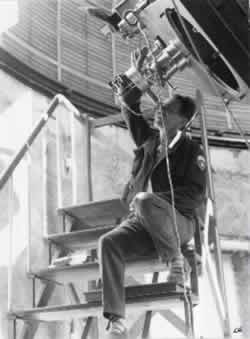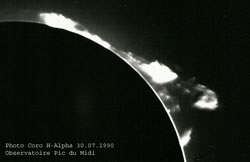
Sun-Earth Day Presents: Eclipse, In a Different Light
Humans create the first artificial solar eclipse to study the corona.
TECHNOLOGY THROUGH TIME ISSUE #45: CORONAGRAPH

Bernard Lyot sitting at his Coronagraph at the Pic du Midi observatory in France ca 1939. (Courtesy: American Museum of Natural History)
For thousands of years, humans had stared at the sun during total eclipses, marveling and even trembling at the halo of greenish light that surrounded the blackness like the iris of some malevolent eye. The likeness to a human eye was not lost on civilizations as ancient as the Egyptians, and for whom the vengeful Eye of Horus may have been its antecedent. But to study this ineffable glow in more detail, only the rare total solar eclipse provided the means. By the late 1800’s astronomers and solar observers realized that the corona was the key to understanding many solar phenomena, perhaps even the mysterious aurora borealis themselves.
In 1930, Bernard Lyot (1897-1952) invented an instrument that allowed total solar eclipses to be recreated at will, and at a time and place of human choosing. He called it the Coronagraph. It is one of the simplest instruments in its design, but its construction is a challenge to both opticians and engineers.
The first element of a coronagraph is an optical refracting telescope. The lenses have to be made of virtually-perfect glass so that there are no bubbles, striations or other defects in the glass. If this is not the case sunlight scattered from these imperfections will flood the field of view and render the faint corona invisible. Next, a small disk is placed in the focal plane to exactly cover the disk of the sun, just as the disk of the moon would. This coverage must be exact because even the slightest glint of sunlight around the edge of the disk will swamp the corona. Great care is taken to reduce scattered light reflecting from the inside of the telescope tube by mounting a series of diaphragm stops inside the coronagraph tube. A second telescope then images the light from the un-eclipsed corona onto a photographic plate or eyepiece. Filters are also used to improve the performance of the instrument and correct for chromatic aberration – a common problem with refractors.

Coronagraph image taken July 30, 1990 at Pic du Midi Observatory (Copurtesy: Pic du Midi)
Lastly, observations need to be carried out under the most favorable atmospheric conditions - clean air being absolutely essential - so that coronagraphs are normally installed at high-altitude stations. Even the slightest haze in the blue sky will mask the corona.
When the observations are completed, beautiful daytime pictures of the corona can result.
Coronagraphic techniques are also used by astronomers to study disks of planet-forming dust around nearby stars (like Vega, Fomalhaut and beta Pictoris) and will soon be used to actually image extra-solar planets in NASA’s Terrestrial Planet Finder project due for launch in 2014.
"I Say Corona, and you say Corono"
Because the name of the instrument is derived from the word ‘corona’, the proper spelling for the instrument is ‘coronagraph’. A GOOGLE search shows that the correct spelling is used on about 149,000 pages and the wrong form on about 36,000 pages. Scientific resources rarely use the incorrect spelling.
RELATED SITES
Technology Through Time
ISSUES
- #46: The Magnetic Sun
- #45: Coronagraph
- #44: Einstein
- #43: Coronium
- #42: The Sun - In a Different Light
- #41: Gallery of Drawings
- #40: First Sun Photo
- #39: Solar Spectroscopy
- #38: George Ellery Hale
- #37: Coronal Mass Ejections
- #36: First Corona Descriptions
- #35: First Sunspot Drawing
- #34: Ptolemy
- #33: Ancient Greece
- #32: Ancient Babylon
- #31: Galileo Galilei
Eclipse Fact
There are at least 2 solar eclipses per year somewhere on the Earth.


